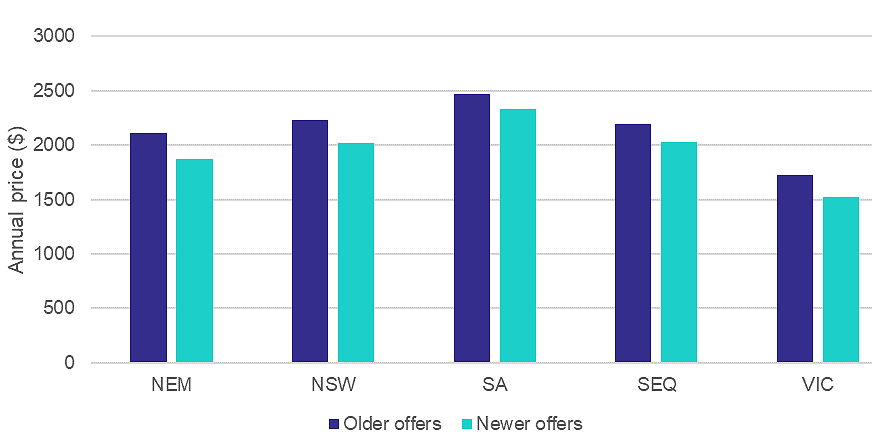
The Australian Competition and Consumer Commission (ACCC) estimates more than 80% of National Electricity Market (NEM) households are paying more for electricity than they need to.
NEM states include Queensland1, New South Wales (and ACT), Victoria, Tasmania and South Australia – so, covering the majority of Australia’s population.
The ACCC’s finding is related to its latest publication – “Inquiry into the National Electricity Market report – December 2024” – which was released yesterday.
The Commission says many households remain on market offers priced at or above the government safety net prices (aka standing or Default Market Offers). These “safety nets” are designed to ensure those who haven’t selected a market offer aren’t gouged (too much). But those who do engage with market offers – most of us – are fair game it seems.
“If you haven’t changed electricity plans in the past 12 months, chances are you are paying more for your electricity than you need to,” said ACCC Commissioner Anna Brakey.
How much more could be significant. The ACCC indicates households on offers more than a year old are paying on average $238 more per year than households on newer offers, and the ‘loyalty penalty’ increases with the age of the offer.
The Commission found 59% of customers on flat rate offers over 2 years old are on prices at or above the default offers, compared to only 10% of customers on flat rate offers less than 12 months old.
Demand Charges Particularly Problematic
The ACCC also found just over half of customers on flat rate plans with a demand charge component were on offers with calculated annual prices at or above flat rate Default Market Offers.
Demand charges, or tariffs, can be very nasty. Plans with a demand charge component may offer cheaper grid electricity per kilowatt-hour, but also a demand charge based on peak power draw in kilowatts. Go over the threshold by running multiple power-hungry appliances concurrently, even just briefly, and an extra charge may be applied for every day of the billing period that could wind up being hundreds of dollars in total.
Comparing Electricity Plans Made Simple(r)
Trying to compare energy retailers by going to each company’s web site can be a very time-consuming and frustrating experience.
The ACCC recommends households in NSW/ACT, QLD, SA and TAS try comparing retailers on the Government website EnergyMadeEasy, and those in Victoria use Victorian Energy Compare.
But while you’re here, check out SolarQuotes’ easy-to-use electricity plan comparison tool. While it’s designed with solar households in mind, those without solar panels should find it useful too; and it’s regularly updated.
If that still seems too much work, you could simply call your energy retailer to see if they have a better offer available. Or even just check your last bill. Guidelines that came into effect on September 30, 2023 in the NEM (2019 in Victoria) require a “better offer” or “best offer” message on the first page of a bill periodically (at least every 100 days) based on a customer’s annual usage; and there may be a similar flag in your electricity account online interface.
Here’s an example of such a message from our most recent electricity bill:
But remember, the flag only relates to plans from your current retailer. The ACCC has also expressed concerns retailers are regularly re-using offer names, which may be confusing for customers and undermine the effectiveness of the messages.
The best electricity plan for households with solar power systems isn’t necessarily the one with the highest feed in tariffs; rather one with a good balance of FiT rates (such as they are these days), and comparatively low consumption and daily charges.
Most solar-only owners are probably better off on a flat rate tariff, but those with solar and batteries will often find a Time of Use (ToU) tariff plan with lower off-peak and shoulder rates is better. But check the fine print as some ToU plans may have components varying by season – and watch out for demand charges on ToU offers too.
Footnotes
- For the purposes of the ACCC’s report, only South-East Queensland is included. ↩



 RSS - Posts
RSS - Posts



My experience being a loyal customer is that “you with get shafted every day of the week”. No respect or rewards for people who are too lazy to shop around. Always try to get three quotes. Read reviews. Research so your knowledgeable.
I’ve moved twice in the past year, because retailers believe you will eventually pay the loyalty tax there are some nice incentives to switch. I’ve also managed to retain a 7c FiT which seems reasonable in the current climate.. Having good data on your usage makes selecting plans far easier too. With Energymadeeasy it’s really simple to shop around and initiate a switch.
I have been trying for 3-4 months to find a plan for my new home and the “energy made easy” website is not easy, it’s useless. In the beginning I chose the 3 least expensive options, visited their websites for more complete details but got redirected back to the same pages from “Energy made Easy”, I then requested quotes from all 3 suppliers, they all came back with quotes that in every aspect were 20-50% higher than the details from EmE. After responding to these quotes with suggestions of what to do with the rough end of a pineapple (metaphorically speaking) I put aside an hour or so to speak to my supplier at the old address, 1of the 3, as to why their quote was so different than their offer in EmE , they told me it was because the new address had a DIGITAL meter and AUSGRID supplied at a different rate for different times to premises with a digital meter, so it was out of their control. Now I have Solar panels, a battery coming soon and an EV I am trying to find a more appropriate deal, but it’s the wild west out there, I followed up on what seemed a great offer with multiple discounts and 12 cents per Kwh, for the 1st. x kwhs, but I pulled out at the last step because I was signing up for 12 months of direct debits without actually being able to view the contract, only the benefits from the sales blurb but not the potential pit falls. It’s really depressing.
Hi Richard,
Energy Made Easy… doesn’t really do what it says on the tin sadly. There are much better options, like Solar Analytics which comes with a CatchControl device.
Many plan picking programs still rely on the retailers uploading their info to Energy Made Easy as a database, as they’re obliged by law.
I use this comparison service. Pay your subscription and the promise they’ll save you more than it costs.
Set up automatic forwarding of your bills and they’ll let you know when better deals crop up.
https://www.billhero.com.au/
Full disclosure, if somebody signs up using the code below, both they and myself will get an additional two months of Bill Hero for free.
bh11811-nmp1668684689
Energy made easy needs to incorporate (at the minimum) electricity plans with fixed monthly fees into their comparison algorithm. Convert it to an effective daily charge and add to the daily fee. Then compare for usage. It doesn’t seem to do so and skips over some fairly decent plans with much lower per kWh charges. Makes the tool quite useless as it stands.
Isn’t Solar Quotes owned by a retailer? Just saying.
Some of us choose our energy provider according to how much they have in the way of green credentials. This article doesn’t seem to address that.